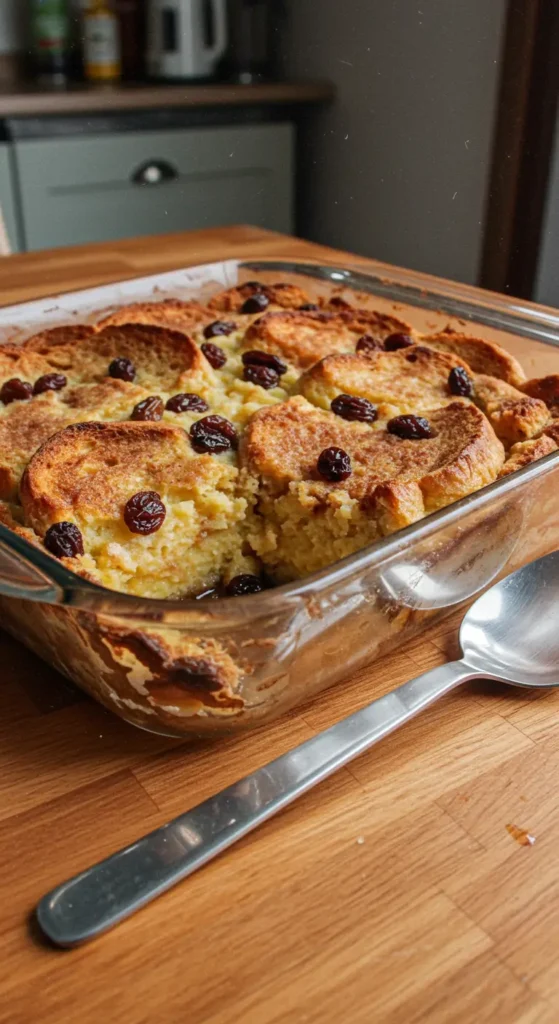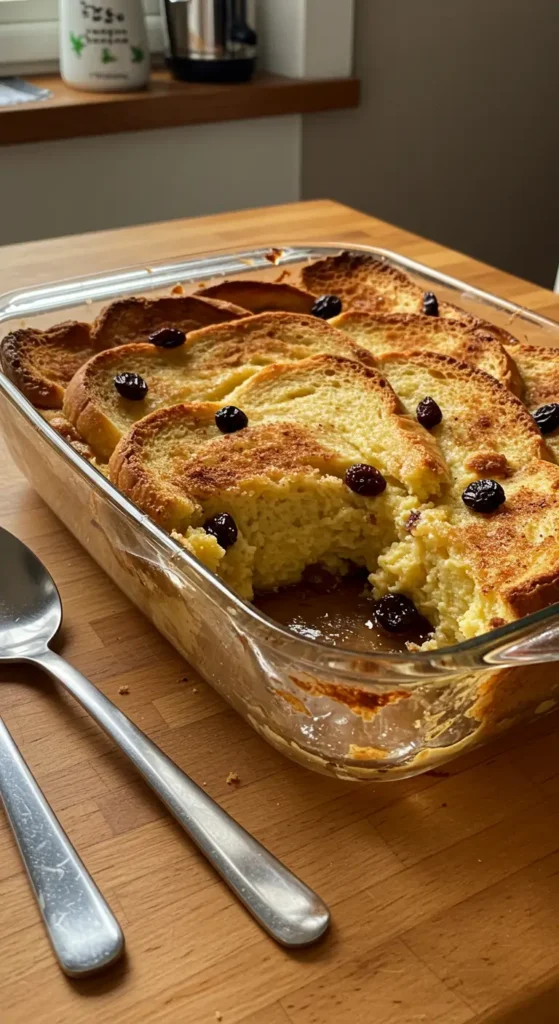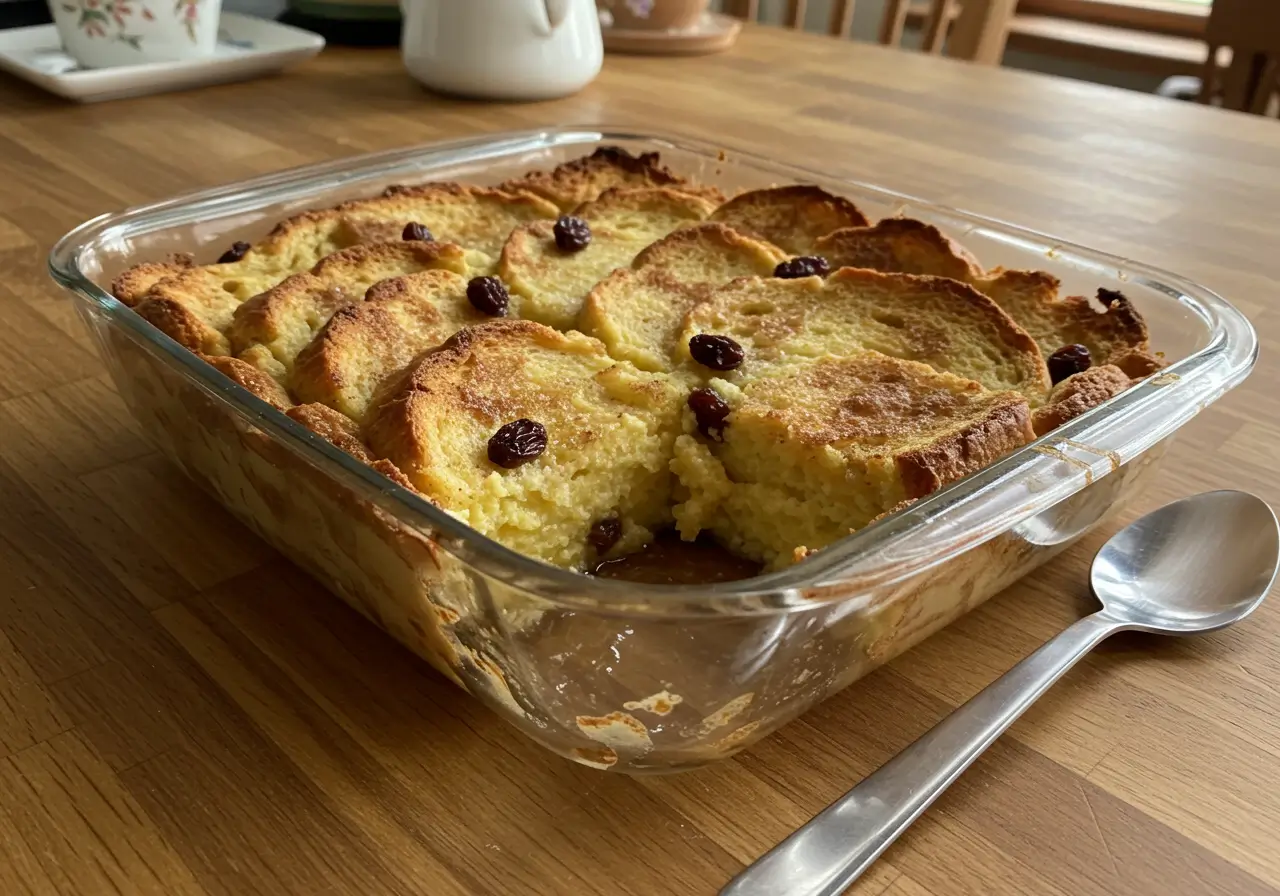Bread Pudding
Table of Contents
Who knew that something as humble as leftover bread could turn into one of the coziest, most nostalgic desserts ever? Bread pudding is the heartwarming answer to that question — a no-waste dish that transforms everyday ingredients into pure comfort food. Whether you’re craving something sweet, savory, creamy, or even spiced, bread pudding offers a blank canvas for culinary creativity.
In this comprehensive guide, we’ll explore everything from the dish’s rich history to modern twists, baking techniques, storage tips, and healthy swaps. Plus, you’ll learn how to master this classic from scratch — even if your only ingredient is stale bread!
Ready to turn crumbs into gold? Let’s get started!
Classic Bread Pudding Recipe

Ingredients You’ll Need for Traditional Bread Pudding
To make a classic bread pudding, you really don’t need much — and that’s what makes it so lovable. With just a few kitchen staples, you can whip up a dessert that feels like a warm hug in a bowl.
Here’s what usually goes into the mix:
- Day-old bread, torn into bite-sized pieces (think French bread, brioche, or challah)
- Milk (whole milk or half-and-half for extra richness)
- Eggs, to create that custardy base
- White or brown sugar, depending on your flavor preference
- Cinnamon and vanilla extract, for that cozy, nostalgic taste
- Optional add-ins, like raisins, chocolate chips, or chopped nuts
It’s a budget-friendly recipe that uses what you already have. And guess what? That loaf you were about to toss just got promoted to dessert royalty.
Step-by-Step Method for the Perfect Bake
Alright, let’s break it down. First, preheat your oven and lightly grease a baking dish. Toss your bread cubes in, drizzle with melted butter, and sprinkle in those tasty extras if you’re using them.
Next, whisk the eggs, milk, sugar, cinnamon, and vanilla in a bowl. Pour this sweet custard over the bread, making sure it soaks through evenly. Press the bread down gently — you want every bite to be rich and creamy.
Then bake it until the top is golden and springs back when pressed. That’s when the magic happens — the outside crisps up while the inside stays soft and custardy. Bread pudding doesn’t get more classic than this.
Best Types of Bread for Bread Pudding

Stale but Strong: Ideal Bread Textures and Types
Let’s talk bread — because not all loaves are created equal when it comes to making bread pudding. The best bread for the job is slightly stale but still firm. Why stale? It absorbs the custard better without turning into mush.
Your go-to should be a sturdy loaf that holds its shape, like:
- Challah — slightly sweet and eggy
- Brioche — rich, buttery, and super soft
- French bread — neutral and crusty
- Sourdough — tangy and hearty (great for depth of flavor)
Avoid super soft sandwich bread — it just doesn’t hold up as well. You want something that’ll soak up the custard but still offer a little chew.
Challah vs Brioche vs Sourdough: Which Makes It Better?
Challah and brioche are often neck-and-neck in the bread pudding game. They both bring sweetness and richness to the table, making them ideal for desserts. Brioche leans buttery, while challah has more of a honeyed flavor.
Sourdough, on the other hand, adds a tangy twist. If you’re after a more rustic vibe, it’s a fantastic choice. Want a little crunch? Use day-old French bread for a firmer texture.
In the end, the best bread depends on the flavor you’re going for. But one thing’s for sure — if the loaf’s stale and sturdy, you’re halfway to pudding paradise.
Sweet and Savory Variations of Bread Pudding
Sweet Takes: Chocolate, Banana, and Raisin Twists
Bread pudding is basically a dessert playground. Once you’ve nailed the base recipe, you can jazz it up with a wide variety of flavors. Want something rich and indulgent? Toss in a handful of chocolate chips or a swirl of caramel. Prefer something fruity and fresh? Sliced bananas, diced apples, or even dried cranberries add a natural sweetness that pairs beautifully with custard.
One crowd-pleaser? Bread pudding with raisins — it’s a cozy, classic combo that brings a nostalgic twist to every bite. Sprinkle cinnamon or nutmeg on top, and it smells like the holidays.
Here’s a tip: Layer your extras between the bread cubes instead of just dropping them on top. That way, every spoonful’s got a little surprise.
Savory Versions: Cheese, Herbs, and Bacon Ideas
While sweet versions steal the spotlight, savory bread puddings are just as satisfying — and they’re perfect for brunch. Think melty cheese, fresh herbs, sautéed onions, or mushrooms folded right into the mix.
Still, a savory spin can be hearty, comforting, and incredibly versatile. Just skip the sugar and switch the custard to something more neutral or even cheesy.
For more delicious recipes, check out our Ultimate Lamingtons Guide — a fluffy, coconut-covered treat worth trying next!
Storage, Freezing, and Reheating Tips
How to Store Bread Pudding in the Fridge
So, you’ve made a big batch of bread pudding — now what? If you’ve got leftovers, storing them the right way makes a big difference. First, let the pudding cool completely. Don’t rush this part or you’ll end up with soggy storage.
Next, cover it tightly with plastic wrap or transfer it to an airtight container. Keep it in the fridge, and you’re good to go for up to three days. It stays moist, flavorful, and ready to reheat whenever the craving strikes.
Freezing Bread Pudding Without Losing Texture
Freezing bread pudding is easier than you might think. Just be sure to use a freezer-safe dish. Wrap the cooled pudding in a layer of plastic wrap, followed by foil. Pop it in the freezer, and it’ll keep for up to three months.
When you’re ready to eat it, thaw it in the fridge overnight. Then reheat it in the oven at a low temp to bring back that soft, custardy goodness. Microwave? It works, but oven’s better for texture.
Healthier and Dietary-Friendly Bread Pudding Options
Gluten-Free and Vegan Bread Pudding Recipes
Want to enjoy bread pudding without the guilt — or gluten? It’s totally doable. Swap in gluten-free bread and use a plant-based milk like almond, soy, or oat. For the custard, whisk together flaxseed or chia eggs with a touch of coconut cream.
Flavor-wise, you can still go big. Add cinnamon, vanilla, and fruits just like the classic. And yes, it still gets golden on top and creamy inside.
Lower Sugar and Dairy-Free Substitutions
Cutting back on sugar? Use mashed bananas, maple syrup, or even applesauce for natural sweetness. These not only replace some of the sugar but also add great flavor.
Dairy-free? Skip the regular milk and butter. Coconut milk brings a rich, tropical twist, while nut-based milks keep it light. Even olive oil or vegan butter can step in without changing the texture too much.
With a few smart swaps, bread pudding becomes a dessert anyone can enjoy — no matter the diet.
Expert Tips and Common Mistakes to Avoid
Getting the Right Texture Every Time
One of the biggest keys to a perfect bread pudding is texture — soft in the center, crisp on top. To get it just right, use day-old bread that’s firm enough to soak up the custard without turning mushy. Also, make sure to press the bread gently into the mixture before baking. This helps every piece soak up that sweet, creamy goodness.
And don’t rush the oven time! Bake it low and slow so the custard sets evenly.
Why Your Bread Pudding Might Turn Out Soggy or Dry
Soggy? You may have added too much milk or used bread that was too soft. Dry? It could be overbaked or missing enough custard to soak through. Another common mistake is skipping the resting time after baking. Give it 10–15 minutes to set before serving — this locks in the moisture and makes slicing easier.
Bread pudding may be simple, but a few smart steps go a long way.
Print
Bread Pudding
- Total Time: PT1H
- Yield: Serves 6–8 1x
- Diet: Vegetarian
Description
This classic bread pudding recipe transforms leftover bread into a warm, comforting dessert using a rich custard base, cinnamon, and vanilla. It’s simple, nostalgic, and perfect for breakfast, brunch, or dessert.
Ingredients
- 6 slices day-old bread, torn into pieces
- 2 tablespoons unsalted butter, melted
- ½ cup raisins (optional)
- 2 cups whole milk
- ¾ cup white sugar
- 4 large eggs, beaten
- 1 teaspoon ground cinnamon
- 1 teaspoon vanilla extract
Instructions
- Preheat your oven to 350°F (175°C). Lightly grease an 8-inch baking dish.
- Spread the torn bread pieces evenly in the dish. Drizzle with melted butter and sprinkle with raisins if using.
- In a medium bowl, whisk together milk, sugar, eggs, cinnamon, and vanilla extract until well blended.
- Pour the custard mixture over the bread. Gently press down the bread so it absorbs the liquid evenly.
- Bake in the preheated oven for 45 minutes, or until the top is golden and springs back when lightly pressed.
- Let cool slightly before serving. Enjoy warm with vanilla sauce, whipped cream, or ice cream.
Notes
- For added richness, use brioche or challah bread.
- You can substitute white sugar with brown sugar for a deeper flavor.
- Add mashed bananas to reduce sugar content naturally.
- This dish can be made ahead and reheated before serving.
- Prep Time: PT15M
- Cook Time: PT45M
- Category: Dessert
- Method: Baking
- Cuisine: American
Nutrition
- Serving Size: 1 slice
- Calories: 165
- Sugar: 19g
- Sodium: 140mg
- Fat: 5g
- Saturated Fat: 2g
- Unsaturated Fat: 2g
- Trans Fat: 0g
- Carbohydrates: 27g
- Fiber: 1g
- Protein: 5g
- Cholesterol: 70mg
Keywords: bread pudding, classic dessert, leftover bread recipe, cinnamon pudding, vanilla bread pudding, easy baked dessert, custard dessert
FAQs About Bread Pudding
What is bread pudding made of?
Bread pudding is made from a mix of stale bread, eggs, milk (or cream), sugar, and spices like cinnamon or nutmeg. Everything gets soaked together to form a rich, custardy mixture, then baked until golden brown. It’s simple, comforting, and a great way to use up leftover bread.
Is bread pudding supposed to be served hot or cold?
Here’s the good news — it’s delicious either way! Many people prefer bread pudding warm, especially with a drizzle of vanilla sauce or a scoop of ice cream. But it also holds up well when served cold, especially after it’s had time to set in the fridge. It’s really a matter of taste!
Can you make bread pudding ahead of time?
Absolutely. In fact, making it ahead can improve the flavor. You can prepare the full dish and keep it in the fridge overnight before baking. Or bake it ahead, refrigerate, and reheat when you’re ready to serve. Just be sure to store it tightly covered to keep it moist.
What can I use instead of eggs or milk in bread pudding?
For egg-free versions, try flax or chia seed “eggs.” As for milk, plant-based options like almond, oat, or coconut milk work beautifully. These swaps let you enjoy bread pudding while staying true to your dietary needs.
Why is my bread pudding soggy in the middle?
Usually, soggy bread pudding means it wasn’t baked long enough or had too much liquid. Always use firm, day-old bread and make sure the custard is fully set before removing it from the oven.

